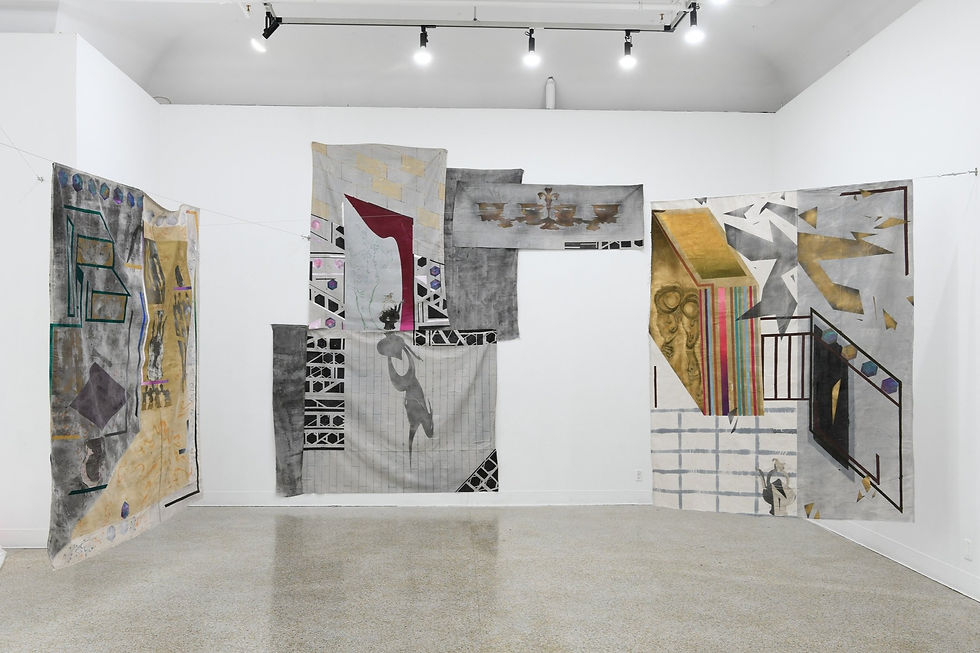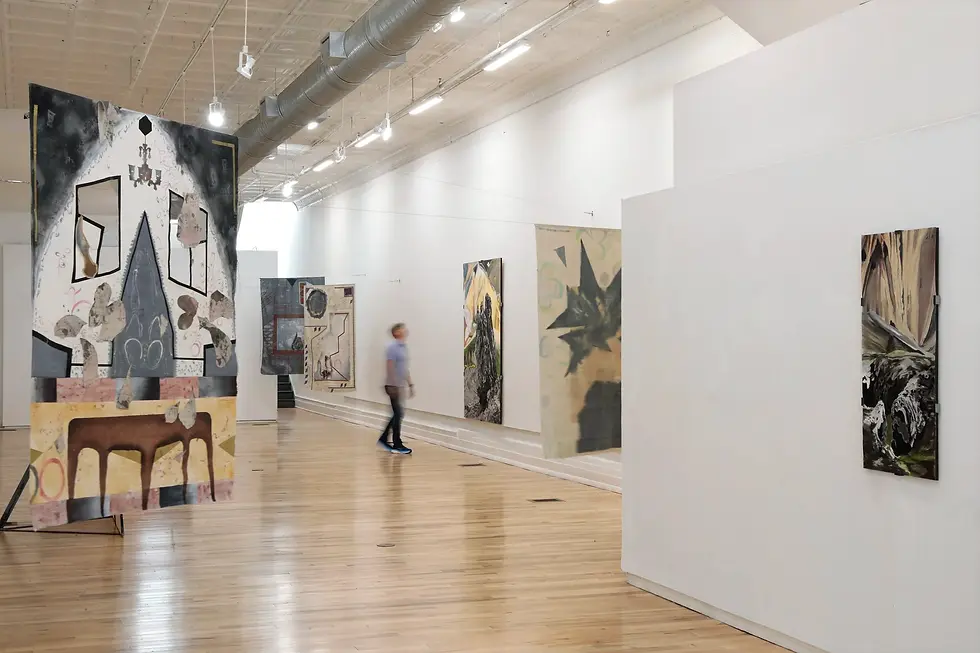Ali Kaeini: Fluidity, Memory, and Illusionary Reclamation.
- Monica Loughman

- Sep 5
- 7 min read
Fluid yet firmly rooted, Ali Kaeini’s practice moves between memory, material, and myth, weaving together the weight of cultural history with the immediacy of lived experience. From natural dyes made of saffron to the shadowy silhouettes of stolen artifacts, his canvases carry both personal and collective narratives of displacement, identity, and reclamation. Drawing on Iranian classical poetry and everyday fragments of Tehran, Kaeini builds layered worlds that are at once fragile and enduring; spaces where illusion, interpretation, and preservation converge.
Ali Kaeini earned his MFA from Virginia Commonwealth University in 2023. He has received the MacDowell Fellowship, the Lighthouse Works Residency, Hamiltonian Artists Fellowship, the VCCA Artist of Color, and attended the Skowhegan School of Painting and Sculpture and Wassaic project residency. In 2024, he was also a recipient of the VMFA Professional Award. His work has been exhibited in solo and group shows across the U.S. and the Middle East, including at DDDD in New York, Delgosha Gallery in Tehran, and the Virginia Museum of Contemporary Art (VMOCA). He currently lives and works in Brooklyn, NY.
I'd like to start our conversation by talking about your body of work Like Water, Like Wind from 2021. Many of the pieces in this series have poems as subtitles . Can you speak to the origins of these stanzas and how they relate to what we see on canvas?
I see Iranian classical poetry, particularly here Hafiz and Khayyam (which I used as subtitles for those works) as very fluid, like water. They're so flowing that they can take on the shape of anything that tries to contain them. All the works in this series are really just one thing, with that same fluidity. I doubt if I changed many of them, it would make any difference to anyone - or even to me! I'd like to say that the imagery in Like Water, Like Wind is like how we do fortune telling, or faal, with Hafiz’s poetry - you just have your own interpretation.

And we, that now make merry in the Room
They left, and Summer dresses in new Bloom,
Ourselves must we beneath the Couch of Earth
Descend ourselves to make a Couch for whom?
Fluidity in form and interpretation is really interesting, especially when considering themes like displacement, identity, and memory that you say guides your overall practice. When did theses themes first begin to take shape in your work?
Winter of 2021! It has always been with me, I’d say, but I found out at that exact time that it was clear enough to visualize them and talk about it at the same time.
It started with the material. I began experimenting with making my own material, especially natural dyes. For a long time, I kept asking myself why I had to use traditional painting materials like acrylic or oil, but I didn’t really have an alternative.
When I first moved to the U.S., like many other Iranians, I brought a lot of saffron with me—it’s so common in Persian cooking but not very common here. I didn’t end up using it much in my food, so at some point I thought, okay, instead of carrying it around all the time, I’ll paint with it. That experiment led me to making dyes from other things like beets, cabbage, spinach, turmeric, coffee, and so on. I started with small paintings and then moved on to larger ones. In the beginning, using these materials on raw canvas made painting feel very casual and natural for me and that feeling has stuck with me since.

So it started with experimenting with medium using a spice you carried from Iran, your home. That sentiment makes me curious about the formal elements that recur throughout your practice: architectural lines and abstract calligraphic marks, freely hanging canvases and vessel-like silhouettes, scissors and vessels. Can you provide context for this imagery and how they relate to those themes (displacement, identity, and memory)?
These are, first of all, images from childhood. My grandmother’s house, the backyard, the midtown streets of Tehran, the calligraphy-like graffiti marks, or the city’s temporary water or electricity markings on the asphalt, next to the explosion marks from homemade fireworks used for the Chaharshanbeh Soori celebration—all on brick walls and asphalt. The vessels are my bodies. They are human bodies like Khayyam says, and at the same time, they are clay, metal, or whatever material they were originally made of with an identity. They are fabric. They are the object they look like, but also the object they are. And the suspended canvases in the space convey the fragility of walls—whether borders, protection, or limitation—all at the same time.

All the objects are cutouts of the silhouettes of stolen objects in museums around the world. I never got the chance to travel much—just the U.S. and Turkey. So, I’ve only visited a few museums in these two countries and many in Iran. I’d say that me, and many other Iranians, even if we're interested, never really get the chance to see most of the ancient and historical objects from Iran because they’re kept in different museums outside the country. So I kind of steal these shadowy silhouettes back into my paintings!
That gesture of reclaiming and object, but as an illusion, speaks to the jagged sense of uncertainty and longing in your work I’m Not Sure if it was a Hoopoe or a Decanter (2023). How does illusion play into your thinking around cultural preservation and identity?
I’d say through transparent layers, a rusted and dusty color palette, stretched shapes and long shadows, eclipses, and flat shapes and forms. When I say flat, I mean it in relation to flattened history or identity—it’s like one dimension is not recognizable, not by us and not by others. I insist on this flatness and layering because I think it’s related to my own experience of not being able to understand things beyond a certain point. Even if you share a lot of information, it’s like layering papers—it still doesn’t invite the stranger into the actual three-dimensional world. This miscommunication might go both ways, though. Also, about the shapes—they function as one thing, but look like something else. Like a kettle shaped like an eagle, which now lives in a museum as a decorative object or a lab mouse for historical research.

You've described your approach to traditional techniques as “rebellious.” Can you share examples of how you've departed from convention, and what inspired that shift?
My works are visually inspired by Iranian art and architecture, but not in terms of technique. I’d say it’s more about how, conceptually, I like to manipulate it. I don’t mind going very far from what “Iranian art” looks like in terms of aesthetics and or technique, but it’s like I’m still there—just at the border, or in the grayest area.

“Earth Blossom” installation view, 1708 Gallery, Richmond, Virginia, 2023. Photo courtesy of David Hale
Your work has been exhibited both in the U.S. and in the Middle East. How have audiences in each context responded differently to your themes?
I’ve changed, and my work has changed over time. I’ve never shown the work I made in Iran in the U.S., and vice versa. But I’d say Iranian viewers have more knowledge of the iconography of my works, which helps them read the motifs and patterns faster and in a more layered way. On the other hand, non-Iranians have a more pure approach to my work, which helps it be read visually and conceptually for what it is. Having non-Iranian viewers actually helps me in some ways—it makes me check that my visual language is clear, honest, and developed enough. It also pushes me to find a more updated,
ironic language.

You’ve attended residencies such as Skowhegan, MacDowell, and most recently Lighthouse Works. How have these environments influenced your process or thinking?
Each place is a different experience—it depends on when you go, where you are in your life and art life, the people you meet, the season, everything. In these residencies, I felt like it’s a time in life all dedicated to me and my art, so for that reason, every moment feels nourishing—even if I’m just sitting and doing nothing or taking an afternoon nap. My relationship with each residency depends on what they offer and how that aligns with what I need at the time. It takes research and getting information beforehand, but I also learned to be flexible and open—to make the best out of it, whether it's for making art, doing research, resting, or building community. All of it fuels me to be productive, both during the residency and after.
I also just finished the Lighthouse Works residency, which was a very special experience—different in terms of scale and the number of residents. Isolating on an island with people you just met, and sharing deeply—thoughts, art, life—it’s a kind of luck. That made it, and other similar smaller residencies, feel more unique as a space for rediscovering yourself.

What are you currently working on, and how does it connect to or diverge from your past work?
I’ve been working on a new project since the Lighthouse Works residency, based on several sketches I made over the past year. It’s more figurative—paintings and drawings I’m doing after a long time. I think, after a while, I finally felt I have a compelling reason conceptually and aesthetically to make figurative work without constantly questioning myself—like, why make figures when abstract painting feels more pure and communicative? Still, the combination of geometric and organic elements, and the layering aspect of my work, remains.
Stay up to date with Ali Kaeini at : www.alikaeini.com or on Instagram @alikaeini.




Comments